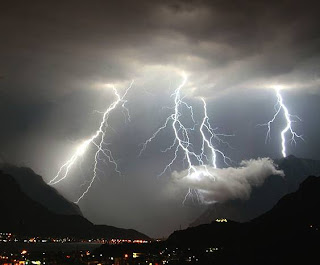Another fact is that lightening tends to strike the tallest objects. Some people believe that installing a lightning rod will stop their home from being struck when it actually increases the probability because it increases the height of what can be struck. And lightning rods direct the currents into the ground through a selected path to prevent as much damage as possible.
Wednesday, May 25, 2011
Long Shot
 |
| As shown here, lightning can strike far away from its point of origin. |
Another astounding fact is that lightning can strike miles away from the storm that made it. One strike has actually been recorded to be 50 miles away from the source. The strikes made at these large distances tend to be rather rare. Amazingly though most lightning strikes tend to be within at least 10 miles from the storm. Which is still quite a rather large distance so whatever you do don’t fall into false security if the storm is not directly above you because even with a large distance it can still strike you or something nearby.
Backwards lightning?
 |
| In this picture, it is easy to sea that visible lightning is actually the return stroke. |
One amazing fact that people do not realize is that the lightening strike we see is its return stroke coming from the ground not the clouds. This is because 99 percent of what is illuminated of what we see is the return stroke and not the sending stroke. People get this confused mostly because of the photography of lightning they see the lightning appears to be going down but that is all. It is an appearance because the return stroke is so fast as it travels up the strike channel and it forms branches causing it to appear to be striking downward.
Where Does Thunders Sound Come From?
The source of the thunder is a hot topic during a thunder and lightning storm. I have personally heard quite a few different answers to this question but the real answer is fairly simple. When lightning strikes, a large amount of electricity is discharged into the ground in just a fraction of a second. As the electricity moves through the air it creates high levels of heat in the air that is close around it. When air is heated it expands, and when it is heated by lightning it does it so fast that is creates the wave of pressure that we hear as thunder.
Monday, May 16, 2011
How lightning is Made
Lightning is made when the right conditions of warm and cold air are mixed. The electricity that makes lightning is made within the storm cloud and is built up little by little until there is enough energy to discharge. Water droplets in warmer air rubs with ice crystals in the cold air while the hot air is rising, this process produces the static electricity needed to build up and strike. The process is a just like a large version of rubbing your socks on a carpet and shocking someone with the built up static electricity.
 |
| This picture is a great example of lightning striking from cloud to cloud and to the ground. |
Subscribe to:
Posts (Atom)